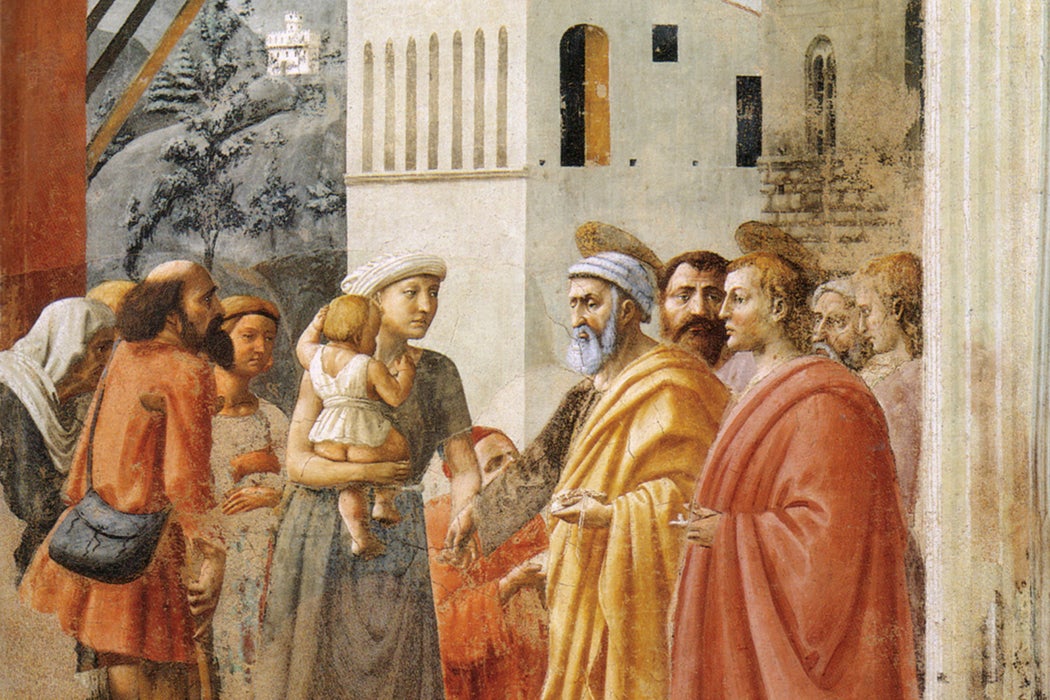Frescoes, perhaps the best-known wall paintings, are the result of a chemical reaction turning paint and wet plaster into a single, solid surface of calcium carbonate. The wall must be wet, hence the name fresco, which means wet, fresh, and cool in one Italian word.
Ideally, the entire painting is applied to the top coat of wet plaster called intonaco and they dry together—meaning during one day. Pausing to consider the size of most frescoes—Masaccio’s Brancacci Chapel murals (1425-1427), Michelangelo’s Sistine Chapel ceiling (1508 – 1512) and the thirteenth-century walls of The Church of Saint Eutrope in Les Salles Lavauguyon—the process seems impossible. In reality, fresco painters painted in sections and interpreted “wet plaster” loosely.
Fresco painting splits loosely into Pre-Renaissance, Renaissance, and Post-Renaissance. Before and after the Renaissance, wall rewetting, adding binding agents to colors and various finishing touches were permitted, as this 1861 article explains. But Renaissance purists found this fresco secco (dry fresco) unforgivably lazy. They developed a new standard called buon fresco (genuine fresco) that was much more rigorous.

Pre-Renaissance, the fresco artist usually applied all layers himself. He began with the arriccio (rough plaster) on the wall, then drew onto the arriccio with charcoal, ochre, and red sinopia. After that, he spread the intonaco onto the drawings in large sections and let it dry. Painting with binder-enriched colors and egg or glue sealants began after the wall hardened. This was fresco secco. The result was beautiful, but somewhat opaque.
Buon fresco was possible because the Renaissance artist could hire an entire team to help. This allowed only spreading enough intonaco for a day’s work—about 1m2 (10ft2). Beginning at the top left-hand corner and working down, the artist traced lines and painted in earth colors. These dried “into” the intonaco for a more vibrant and durable result. Each day, new intonaco slightly overlapped the edge of the previous day’s, creating daily squares called giornate (“daily”).
The grid concept of enlarging drawings also enabled buon fresco. Alberti’s cloth “veil” and the later rete (net) replaced the sinopia method with the cartoon. Cartoons were actual-sized drawings on thick paper either needle-pricked, placed against the wet intonaco and dusted with black or red powder (spolvero), or traced into the intonaco with a stylus. Cartoon preparation happened in workshops. First, a team made small drawings and wax and clay models to study the effects of color, light, and shadow, then an oil painter prepared a colored sketch. It was a stressful labor of love, but even Raphael, Masaccio, and the impatient Michaelangelo suffered it because the result was so beautiful.
Understanding the complexity of fresco makes it even more remarkable that young Masaccio revolutionized European painting with his frescoes. The vaulted ceiling of his “The Holy Trinity” at Santa Maria Novella (1427) and his murals at the Brancacci Chapel of Santa Maria del Carmine (1425-7) show a depth and appreciation of perspective never before seen. He accomplished this at the age of 25, and within the strict time constraints demanded by buon fresco.







